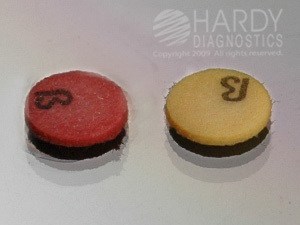Table of Contents
The nitrocefin biochemical test is a sensitive technique for detecting beta-lactamase-producing strains of N. gonorrhoeae, H. influenzae, Staphylococcus spp, Enterococcus spp, and Moraxella (Branhamella) catarrhalis. Nitrocefin is the only reliable test for detecting beta-lactamase-producing Enterococcus spp.
It’s the most accurate test for the majority of b-lactamases. The exceptions are ROB-1, a staphylococcal penicillinase enzyme, and an unusual plasmid-mediated enzyme from haemophili. Another chromogenic cephalosporin PADAC is available, however it is less sensitive and not widely accessible. Beta-lactamase tests that are quick can provide useful clinical information before the MIC and disk diffusion tests.
Nitrocefin is a chromogenic Cephalosporin that transforms from red to yellow when the amide bond within the beta-lactam-ring is hydrogenated by the enzyme beta-lactamase. It is insensitive to hydrolysis by the lactamases that are produced by Gram-positive and Gram negative bacteria.
While the test could be carried out using a nitrocefin-based solution, it is expensive sensitive to light and is not readily available. Many laboratories find it more practical to use a commercially accessible test kit that tests for nitrocefin.
Beta-lactase detection using Nitrocefin solution (Powder):
- A 0.5 mg mM solution of nitrocefin is made through the dissolution of 2.58 mg pure powder into 0.5 milliliters of dimethylsulphoxide (DMSO) and then diluting with 9.5 milliliters of 0.1 M buffer for phosphate, pH 7.0.
- In the case of test isolates, colonies are removed off nutrient agar plate and can be suspended for 20uL amounts that contain 0.1 M of phosphate buffer pH 7.0 creating an intense suspended suspension in a slide of glass along with 20 uL of the nitrocefin solutions are added.
- The activity of b-Lactamase is seen as an orange colour in 1 to 2 minutes.
- In the case of weak reactions, they may be slower to show up and appear, however reactions lasting more than 10 minutes should be approached with caution as they could be a reflection of the secondary ss-lactamase function of penicillin-binding proteins which make unstable complexes of acyl.
Note: The solution will be durable for 10 days at temperatures of 4 degrees Celsius in the foil-wrapped bottle. Glass containers are recommended because DMSO reduces the plastics.
Beta-lactase detection using Nitrocefin disk
- Utilizing sterile forceps, take the Nitrocefin disc from the vial, and then place it on a petri dish or microscopically-sized slide. Place the remaining disks in the freezer.
- Prior to the inoculation, let to allow the Nitrocefin disk to settle to ambient temperature.
- Then, moisten each disk by putting one drop of sterile deionized drinking water. Be careful not to over-saturate the disk, as this could cause the reagent to be diluted.
- With an applicator or loop that has been sterilized, stick, remove a colony that is well-separated and place it on the surface of the disk.
- Examine the inoculated disk for the formation of an orange/red color
Note: Water is essential in the process of forming the color reaction. If the disk starts to dry out, it might be necessary to replenish the reaction zone of the Nitrocefin disk using a tiny volume of water.
Test Results

- Left (H. influenzae): The red/orange color change was a sign that beta-lactamase is positive.
- Right (M. catarrhalis): The development of yellow color was a sign of beta-lactamase negative.
Other techniques
Rehydrate the nitrocefin in the manner directed and then use the solution for the following purposes:
- Direct Plate Method: Place one drop of the nitrogen solution the outside of your colony. If the sample is a producer of beta-lactamase, then the colony as well as the surrounding area will soon become red. To determine if there is a weak beta-lactamase maker, the plate needs to be left to incubate for 30 minutes before reporting it as negative.
- Slide Method: Pour one drop of the mixture to a glass slide that is clean. Utilizing a sterile loop select one colony of the plate and mix it with the drop of nitrocefin. The report is considered positive if the color shifts from red to yellow within thirty minutes (protect your slide against drying out during the time of waiting).
- Broth Method: Use one drop of solution containing nitrocefin 1ml of the grown-up culture. The report is considered positive if the color changes from red to black after 30 minutes.
- Broken Cell Method: Use a Sonicator to sonicate 1ml culture to break the cells. Include 4 drops Nitrocefin solution. The report is positive if the color changes to red in less than 30 min.
- Paper Disc Spot Test: A Whatman No.1 filter paper disc (diameter 7cm) is put in a dish that has been is impregnated with nitrocefin (0-5ml). The impregnated paper is typically usable for a day, but it must be kept from direct light in order to prevent spontaneous degradation. A single colony is glued to the impregnated paper using a an elongated loop. A color change from red to pink within 15 minutes suggests beta-lactamase’s presence.
